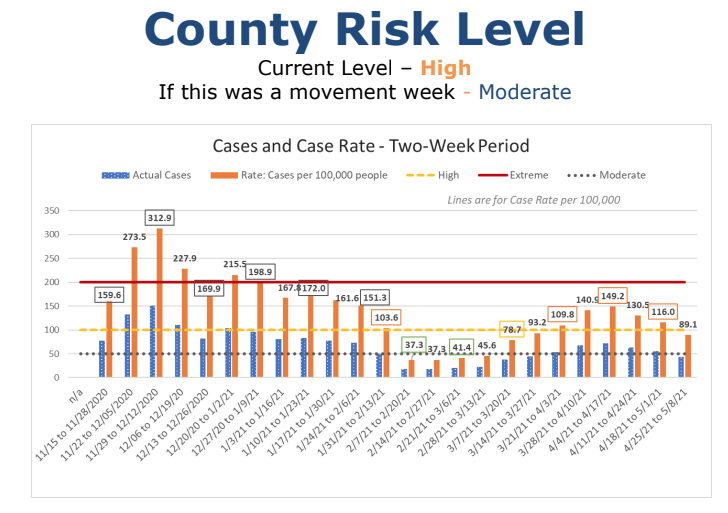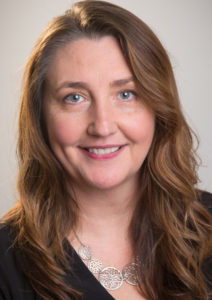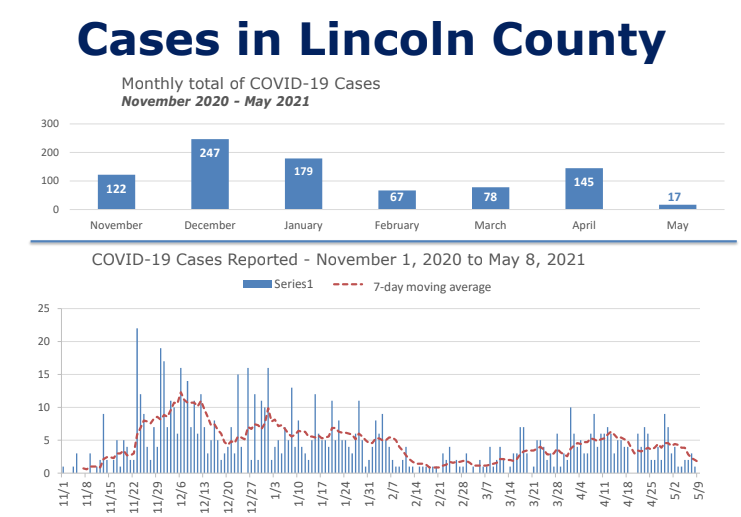
By QUINTON SMITH/YachatsNews.com
Lincoln County is moving Friday from the state’s “high” to its “moderate” risk category for restrictions on business and social activity, Gov. Kate Brown announced Tuesday, and could drop to “low risk” the following week if 800 more people get vaccinated.
The move for Lincoln County was part of Brown’s bigger announcement that gives counties and Oregon a specific roadmap for reopening Oregon’s economy and making a big step back toward normalcy. When 70 percent of the state’s residents 16 and older have received at least one dose of a COVID-19 vaccine, Brown said, the state will eliminate most restrictions meant to hamper the spread of the disease.
That includes the lifting of capacity limits on restaurants, bars, stores, gyms, sporting venues, movie theaters and limitations on the number of people who can gather indoors or out for events such as road races and festivals. No counties will remain under the current “risk level” tiers based on their rates of infections.
The announcement marked a major policy shift in which vaccination rate will now be the key measure of a county’s ability to drop COVID-19 restrictions.
Brown also announced further incentives for counties to get more people vaccinated.
Counties that have 65 percent of their 16- and-older residents with a first- or second dose could move to a “lower risk” level of restrictions as soon as May 21 – and stay there.
Lincoln County’s COVID-19 case rate has dropped significantly the past month, allowing it to move into the “moderate” risk category Friday. But with another 800 vaccinations it could be one of the handful of counties to move to “low risk” the following week.

“It gives us a target,” said Susan Trachsel, spokeswoman for Lincoln County Public Health. “What 65 percent will do is get us to low and stay at low.”
Currently, 26,127 Lincoln County residents age 16 and older have received their first or second vaccine dose, Trachsel said – 63 percent of the 41,414 people in that age group.
“This means we only need 793 more people vaccinated with their first dose to move permanently to low risk,” Trachsel said.

Vaccine rate uneven across Oregon
Brown said the moves were possible because data showing the most recent spike in cases over the past month has begun to fade.
“It looks like we’ve crossed the tipping point of the fourth surge,” Brown said. “Our hospitalization rates have stabilized. Our infection rates are on a downward trajectory. And in the race between vaccines and variants, our efforts to vaccinate Oregonians are taking the lead.”
Benton and Hood River counties are the only two that currently have reached the 65 percent threshold.
Statewide, about 47 percent of Oregonians 16 and older are at least partially vaccinated, but the figures climb to 55 percent in Clackamas County, 61 percent in Washington County and 63 percent in Multnomah County.
Meanwhile, some counties — mostly in eastern or southern Oregon — are far off the mark. In Umatilla, Malheur, Lake, Douglas and Harney counties, only 31 percent to 37 percent of their populations 16 and older are at least partially vaccinated.
Brown’s metrics clearly are meant to encourage more than 2 million Oregonians who have yet to be vaccinated. Oregon Health Authority director Pat Allen said the state needed to inoculate about 430,000 more people to reach the goal by June.
Allen said that high vaccination rates were more important than high infection rates in determining progress against COVID-19. Even if infection rates are high, vaccination rates above 65 percent meant that cases were unlikely to result in severe illness or death.
“So Oregon, this is our goal,” Brown said in a written statement Tuesday. “We each play a part. If you have already been vaccinated, thank you. Now help a friend, family member or neighbor make an appointment.”
The statewide mask mandates on indoor public spaces and physical distancing requirements could, however, remain for some time. The governor said she’d continue to follow recommendations from the Centers for Disease Control and Prevention in determining when to lift mask rules.
“Let’s get this done, let’s get our economy fully reopened and enjoy our summer,” Brown said during a news conference Tuesday, expressing her hope that the 70 percent target will motivate more Oregonians to get vaccinated.
Trachsel said the state target of 70 percent will not get Lincoln County or Oregon to community (herd) immunity, so the state has set a target of 80 percent vaccinated by the end the summer.
“To do this, walk-in clinics are increasing throughout the state,” she said. “Lincoln County has already made all clinics open to walk-ins, and pharmacies are working on plans for that as well.”
Lincoln County Public Health also wants to increase mobile pop-up clinics and is asking businesses, community groups, and large organizations to sign up to bring a clinic to them. This week’s clinics are listed on LCPH’s website. All second-dose clinics — including one at the county fairgrounds in Newport and the Waldport Community Center — are open for first-dose appointments and walk-ins.
Counties and risk levels
Lower Risk (8)
Gilliam, Harney, Lake, Morrow, Sherman, Union, Wallowa, and Wheeler;
Moderate Risk (7)
Coos, Curry, Grant (Moved from High), Hood River, Lincoln (Moved from High), Tillamook, and Wasco (Moved from High);
High Risk (21)
Baker, Benton, Clackamas, Clatsop, Columbia, Crook, Deschutes, Douglas, Jackson, Jefferson, Josephine, Klamath, Lane, Linn, Malheur, Marion, Multnomah, Polk, Umatilla, Washington, and Yamhill.
- The Oregon Capital Bureau and The Oregonian/OregonLive contributed to this report


